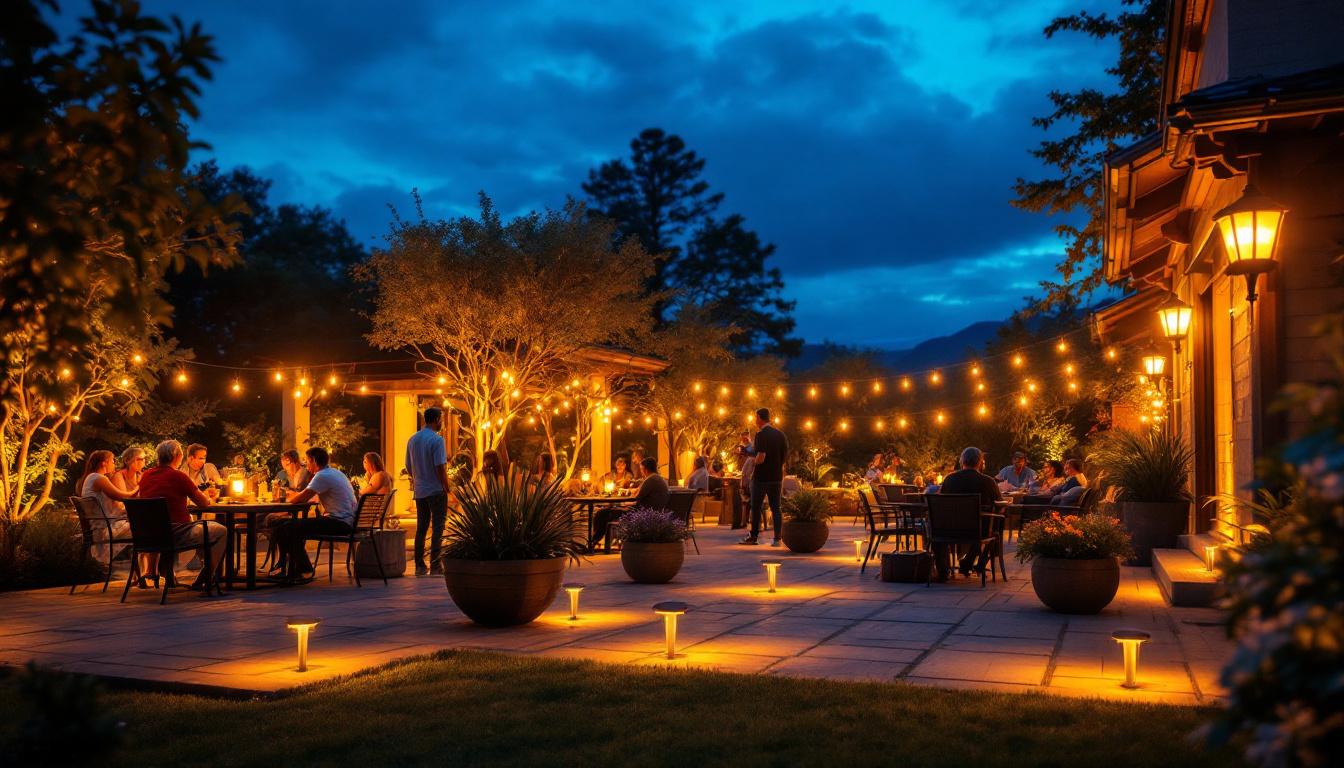
In the ever-evolving world of lighting design, wall bulbs have emerged as a versatile and essential component for creating ambient and functional spaces. This handbook aims to provide lighting contractors with a comprehensive understanding of wall bulbs, including their types, applications, installation techniques, and maintenance tips. Whether you are a seasoned professional or just starting in the industry, this guide will serve as a valuable resource.
Wall bulbs are lighting fixtures that are mounted directly onto walls, providing illumination while also serving as decorative elements. They come in various shapes, sizes, and styles, making them suitable for a wide range of applications, from residential to commercial spaces. Understanding the different types of wall bulbs and their functionalities is crucial for any lighting contractor.
Wall bulbs can be categorized into several types based on their design and functionality. The most common types include sconces, wall-mounted spotlights, and wall washers. Each type serves a unique purpose and can dramatically influence the overall aesthetic of a space.
Sconces are perhaps the most popular type of wall bulb. These fixtures can provide both ambient and task lighting, depending on their design. They are often used in hallways, living rooms, and bedrooms to create a warm and inviting atmosphere. The variety of materials used in sconces, such as glass, metal, or even fabric, allows for a wide range of styles, from modern minimalist to vintage charm, making them adaptable to any interior design theme.
Wall-mounted spotlights, on the other hand, are designed to focus light on specific areas or objects. They are ideal for highlighting artwork, architectural features, or any other focal points within a room. Their adjustable heads allow for versatility in directing light, making them an excellent choice for galleries or homes with unique decor. Wall washers distribute light evenly across a surface, making them perfect for illuminating textured walls or creating a wash of light in larger spaces. This type of lighting can enhance the visual interest of a room, drawing attention to its architectural details.
Wall bulbs are incredibly versatile and can be used in various settings. In residential spaces, they can enhance the ambiance of living rooms, bedrooms, and hallways. In commercial environments, wall bulbs can be used to create a welcoming atmosphere in lobbies, restaurants, and retail spaces. The strategic placement of wall bulbs can not only improve the aesthetic appeal but also enhance the functionality of the space, making it more inviting for guests and customers alike.
Additionally, wall bulbs can be strategically placed to improve functionality. For instance, installing wall-mounted fixtures in stairways or corridors can enhance safety by providing adequate lighting in these often-overlooked areas. The right lighting can prevent accidents and create a more navigable environment, particularly in homes with children or elderly residents. Moreover, the use of wall bulbs in outdoor settings is becoming increasingly popular. Outdoor wall sconces can provide security and illumination for entryways, patios, and gardens, enhancing both safety and aesthetics. These fixtures are often designed to withstand the elements, featuring weather-resistant materials and finishes that ensure longevity and reliability in various outdoor conditions.
Furthermore, wall bulbs can also play a significant role in energy efficiency. With the advent of LED technology, many wall-mounted fixtures now offer energy-saving options that reduce electricity consumption while providing ample illumination. This not only benefits the environment but also helps homeowners and businesses save on energy costs. Incorporating smart lighting solutions into wall bulbs can further enhance their functionality, allowing users to control brightness and color temperature through mobile apps or voice commands, creating a dynamic and customizable lighting experience.
Selecting the appropriate wall bulb for a specific application requires careful consideration of various factors. Lighting contractors must assess the intended use, the existing decor, and the desired ambiance to make informed decisions.
The first step in choosing the right wall bulb is to determine its primary purpose. Is it meant to provide ambient lighting, task lighting, or accent lighting? Understanding the purpose will guide the selection process and ensure that the fixture meets the client’s needs.
For instance, if the goal is to create a cozy atmosphere in a living room, a wall sconce with a warm color temperature would be appropriate. Conversely, for task lighting in a home office, a more focused spotlight may be necessary to provide adequate illumination for work-related activities.
The style and design of the wall bulb should complement the overall decor of the space. Lighting contractors should consider the architectural elements, color schemes, and furniture styles when selecting fixtures. For modern interiors, sleek and minimalist designs may be preferred, while traditional spaces may benefit from ornate sconces or vintage-inspired fixtures.
Furthermore, the finish of the wall bulb can significantly affect its appearance. Options range from polished metals to matte finishes, each contributing to the overall aesthetic. Selecting a finish that harmonizes with other elements in the room can create a cohesive look.
With the growing emphasis on sustainability, energy efficiency is a crucial consideration when choosing wall bulbs. LED bulbs have become the preferred choice for many contractors due to their longevity and low energy consumption. They are available in various color temperatures and can easily be integrated into most wall fixtures.
Contractors should also be aware of the lumen output required for a specific space. The brightness of the wall bulb should align with the intended use, ensuring that the area is adequately illuminated without being overly bright or harsh.
The installation of wall bulbs requires precision and adherence to safety standards. Proper installation not only ensures functionality but also enhances the aesthetic appeal of the space. Here are some key considerations for lighting contractors during the installation process.
Before beginning the installation, it is essential to plan the layout of the wall bulbs. This involves determining the optimal height and spacing for each fixture, considering factors such as the size of the room and the intended purpose of the lighting.
Contractors should also assess the electrical wiring and ensure that it meets local codes and regulations. If necessary, consult with a licensed electrician to address any wiring issues before proceeding with the installation.
When mounting wall bulbs, it is crucial to use the appropriate hardware and techniques to ensure stability and safety. Most fixtures will come with mounting brackets and screws, which should be securely fastened to the wall.
For heavier fixtures, additional support may be required, such as wall anchors or toggle bolts. It is also important to ensure that the fixtures are level and evenly spaced to maintain a professional appearance.
Once the fixtures are mounted, the next step involves making the electrical connections. This process should be approached with caution, as improper wiring can lead to safety hazards. Always turn off the power at the circuit breaker before working on electrical connections.
Follow the manufacturer’s instructions for wiring the fixtures, ensuring that all connections are secure and insulated. After completing the wiring, restore power and test each fixture to confirm proper operation.
Dust and dirt can accumulate on wall bulbs over time, diminishing their brightness and overall appearance. Regular cleaning is necessary to keep fixtures looking their best. Use a soft, dry cloth to gently wipe down the surfaces, avoiding harsh chemicals that could damage the finish.
For more thorough cleaning, especially for fixtures with intricate designs, a slightly damp cloth can be used. Ensure that the fixture is turned off and completely cool before cleaning to avoid any risk of electric shock.
As with any lighting fixture, bulbs will eventually need to be replaced. It is important to choose the right replacement bulbs that match the specifications of the original. This includes considering the wattage, base type, and color temperature.
When replacing bulbs, always turn off the power and allow the fixture to cool down. Follow the manufacturer’s guidelines for replacing bulbs to ensure safety and proper functionality.
Occasionally, wall bulbs may encounter issues such as flickering, dimming, or complete failure. These problems can often be traced back to wiring issues, faulty bulbs, or incompatible dimmer switches. Lighting contractors should be prepared to troubleshoot these common issues.
For flickering lights, check the connections and ensure that the bulbs are securely fitted. If the problem persists, it may be necessary to inspect the wiring or consult with an electrician for further evaluation.
The lighting industry is continually evolving, with new technologies emerging to enhance the functionality and efficiency of wall bulbs. Staying informed about these innovations is crucial for lighting contractors looking to provide the best solutions for their clients.
Smart wall bulbs have gained popularity in recent years, allowing users to control their lighting through mobile apps or voice-activated devices. These bulbs offer features such as dimming, color changing, and scheduling, providing unparalleled flexibility and convenience.
For lighting contractors, integrating smart technology into wall bulb installations can significantly enhance the value of their services. Understanding how to install and configure smart lighting systems can set contractors apart in a competitive market.
As energy efficiency becomes increasingly important, advancements in LED technology continue to improve the performance of wall bulbs. Newer models offer higher lumen outputs, longer lifespans, and better color rendering capabilities.
Lighting contractors should stay updated on the latest energy-efficient options available in the market, as these can provide clients with cost savings and environmental benefits over time.
Wall bulbs are an integral part of modern lighting design, offering both functionality and aesthetic appeal. For lighting contractors, understanding the various types, applications, and installation techniques of wall bulbs is essential for delivering high-quality results to clients.
By staying informed about innovations in lighting technology and prioritizing energy efficiency, contractors can enhance their services and meet the evolving needs of their clients. With this ultimate handbook, lighting contractors are equipped with the knowledge and insights necessary to excel in their craft and create beautifully illuminated spaces.
Ready to elevate your lighting projects with superior wall bulbs that combine quality, efficiency, and style? Look no further than LumenWholesale, where we offer an extensive selection of spec-grade lighting products at unbeatable wholesale prices. Say goodbye to inflated markups and hello to reliable, high-performance lighting that meets the highest industry standards. Plus, enjoy the convenience of hassle-free bulk buying with free shipping, ensuring you get the best value without any hidden fees. Don’t compromise on quality or affordability. Wholesale Lighting at the Best Value is just a click away. Transform your lighting projects with LumenWholesale today.

Discover why LED UFO lights are revolutionizing the lighting industry and becoming essential tools for contractors.

Discover why solar lights are a game-changer for outdoor patios and a must-have for every lighting contractor.

Discover how garage LED ceiling lights are revolutionizing the lighting industry, offering contractors energy efficiency, durability, and superior illumination.

Discover the essential guide for lighting contractors on the integration of sensors and timers.